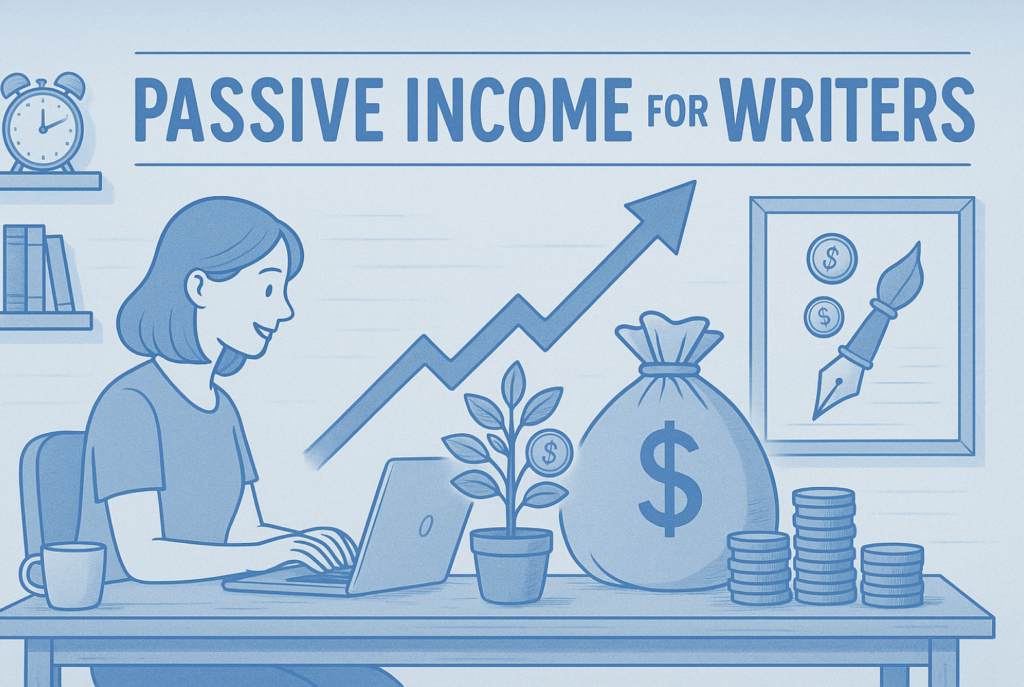Freelance writing offers freedom and flexibility, but it often comes with one big challenge: income inconsistency. Clients come and go, projects end suddenly, and there are always quiet months. That’s why many writers are looking for ways to add passive or semi-passive income to their business model.
Passive income doesn’t mean “earning money while doing nothing” — it usually requires upfront work. But once established, these revenue streams can provide stability, reduce stress, and allow you to be more selective about client projects. Here are seven proven ways freelance writers can build passive income.
1. Write and Sell Ebooks or Digital Guides
Writers already have the most valuable skill for creating ebooks: the ability to communicate ideas clearly.
You can:
- Create how-to guides based on your niche expertise (e.g., “SEO Writing for Beginners”).
- Package your blog posts into a polished ebook.
- Sell ebooks directly through your website, or distribute on platforms like Amazon Kindle Direct Publishing.
Even a short ebook can generate ongoing income once it’s marketed well. The key is to pick a topic that solves a clear problem for readers.
2. Monetize a Niche Blog With Ads or Affiliate Marketing
Starting your own blog is more than just a portfolio tool — it can become a business.
- Ads: By joining ad networks like Google AdSense or Mediavine, you earn money every time visitors see or click ads on your site. You can see two great examples on how to use ads in monetizing you content: Nordnews.se and Fokus24.dk
- Affiliate marketing: You promote tools, books, or courses relevant to your niche, and earn a commission on each sale. For example, a writing blog could recommend grammar tools or freelance platforms like you see on farfarsmad.dk
It takes time to build traffic, but once established, a niche blog can generate recurring income for years.
3. Create a Writing Course or Workshop
If you’ve mastered a specific skill — whether it’s copywriting, blogging, or technical writing — you can package your knowledge into a digital course.
Options include:
- Self-hosted courses using platforms like Teachable or Thinkific.
- Workshops or webinars that can be recorded and sold later as evergreen content.
Courses often bring in higher revenue than ebooks, and they position you as an authority in your niche. The upfront work is significant, but once complete, a course can sell indefinitely with only occasional updates.
4. License Your Writing or Create Templates and Planners
Writers can also earn passive income by creating reusable content.
Examples:
- Blog post templates for businesses.
- Social media caption packs.
- Freelance proposal or contract templates.
- Writing planners or content calendars.
You can sell these through your own site, on marketplaces like Etsy, or on platforms built for digital downloads such as Gumroad. Once created, templates require almost no maintenance but can be sold repeatedly.
5. Self-Publish Fiction or Non-Fiction
If you’ve dreamed of becoming an author, self-publishing is now easier than ever. Platforms like Amazon Kindle Direct Publishing, IngramSpark, or Draft2Digital allow you to publish and distribute globally without needing a traditional publisher.
- Fiction: Short stories, novellas, or full novels in genres like romance, fantasy, or thriller.
- Non-fiction: Practical guides, memoirs, or industry insights.
With good marketing and consistent publishing, self-published authors can build a steady income stream — sometimes even full-time careers.
6. Print-on-Demand and Merchandise
Writers often have a way with words that resonates with people. That creativity can be turned into physical products using print-on-demand (POD).
Ideas include:
- T-shirts with clever writer quotes.
- Journals and notebooks.
- Mugs, tote bags, or posters with literary designs.
Platforms like Printful or Redbubble handle production and shipping, so you only focus on creating designs and marketing. This is not pure writing work, but it allows you to monetize your creativity in new ways.
7. Diversify: Balancing Active and Passive Income
The smartest approach is not to rely solely on passive income streams but to combine them with freelance projects.
- Active income: Client work that pays per word, per project, or per hour.
- Passive income: Ebooks, blogs, courses, templates, or merchandise that bring in ongoing revenue.
This balance ensures stability. During slow freelance months, your passive income helps cover expenses. During busy client seasons, it becomes a profitable bonus.
Final Thoughts
Passive income won’t replace freelance work overnight, but it can dramatically change your financial future as a writer. By investing time upfront — writing ebooks, building a blog, or creating templates — you create assets that continue to pay you long after the initial effort.
For writers, passive income is more than a side hustle; it’s a way to build long-term stability, reduce financial stress, and gain the freedom to focus on the projects you truly love.
